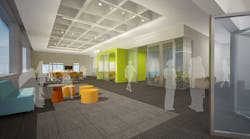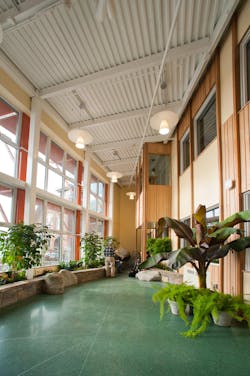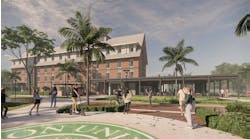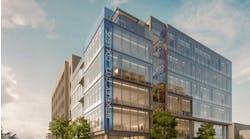If not for their ages, they could have been mistaken for regular members of the commuter workforce, arriving at a nine-story downtown building and punching an elevator button for the ride up to their destination for the day.
But the students who showed up for the first time last month at their new high school in San Diego are not the typical downtown denizens, and their new school, e3Civic High School, is not a typical campus. The charter school opened in September on the sixth and seventh floors of the city’s new central library building.
“We hope to provide a new design for reconsidering urban secondary education as a partnered venture between small high schools and community-based organizations,” the school asserts on its website.
As schools and universities strive to improve the American education system and prepare students for life after their schooling is completed, planners and administrators continue to explore ways of providing innovative learning spaces that make education more effective and stimulating for students.
Mutually beneficial
Placing a high school in a public library building creates the possibility for all kinds of innovation, but the initial impetus for the arrangement was more basic: More classroom space was needed in the downtown area, and the library needed a tenant for two unclaimed floors to get its long-awaited central library project finished. The San Diego Unified School District says some 5,000 students were being bused out of the area because nearby schools were too crowded. Adding the high school—and the $30 million in bond funds used on the space—also helped ensure that the library project could be completed after years of delays.
The concept behind the school is found in its name. The “e3” stands for “engage, educate and empower.” The design aims to push the limits on the definition of a classroom, according to Kate Mraw, an associate and interior designer with LPA Inc., the architect on the project.
The high school states that it is organized around three education principles:
•Personalization. The school says it intends to personalize education “by supporting the development of meaningful, sustained relationships” between faculty, students and the students’ families.•Authentic curriculum. The school describes this as “intellectually challenging work that focuses on deep understanding of core concepts, active learning and real-world application.”
•High standards for all. The school is employing “a rigorous curriculum designed to prepare intellectually curious and engaged problem solvers.”
Interaction encouraged
The facility design put into place at e3 Civic High in response to those principles also is based on three principles: personalization, social connections and flexibility.
“The amount of interaction that takes place is different from a typical educational space,” says Mraw.
That means that learning takes place not only in the classrooms, dubbed “studios” by the school, but also in the corridors, nooks, stairways and open spaces in the facility.
“The design allows for learning to happen anywhere,” says Mraw. “Every space can be used for multiple functions.”
Some of the standout spaces in the school that help foster interaction and student-directed learning:
•The Park. It has a “living room” setting with controllable lighting, soft furniture and technology integration. Its ambience is geared toward a “quiet” learner, but also can be used for activities requiring a larger space.
•The Plaza. It is considered an active gathering space for presentations, performances and dining.
•The Steps. The stairway linking floors six and seven is not just a pathway between classes. The steps are wide enough so that students can gather in small groups for class projects or just social interaction. Or they can double as a kind of amphitheater, where speakers can deliver a talk to students seated on the stairs.
•The Interactive Wall. To incorporate the school corridors as places for learning to occur, the design makes those areas more than just circulation pathways. As students travel from studio to studio, they encounter pullout spaces where they can gather in small groups; tackable walls where they can post information; and writable glass walls where students and teachers can carry on a dialogue that may or may not be connected to classwork, such as an impromptu poll on what is the best park in the city.
“They share ideas as they’re passing by,” says Mraw. “It creates a sense of community.”
•Gallery. This centrally situated space is lined with whiteboard surfaces and specialty lighting intended to be a place where students can display the projects they have developed.
The entry to the school has no enclosed lobby, and the administration space is dispersed throughout the school to create an environment without hierarchy.
The studios are organized into four villages. The studios in a village are clustered around a shared commons and teaming rooms. The studios are L-shaped rooms with multiple teaching walls so that students may be presenting information to their classmates at the same time as a teacher is delivering information elsewhere in the room.
Some of the studios are set up with acoustic treatments and white noise to create quiet areas that accommodate research. Others are designed for more active engagement, with whiteboards and pinup space.
To maintain a separation of the school and the library, e3 Civic High has its own entrance on a side of the building apart from the main library entry for the public. The school entrance leads to dedicated elevators—or a staircase—to take students, staff and visitors directly to the school facility on the sixth and seventh floors.
But the separation does not prevent students from taking advantage of the resources available in the central library of a large city. Students and staff to have easy access to resources that wouldn’t be as plentiful in a typical school: More than 1.2 million volumes in the central library collection; more than 400 public computers and an electronic training area; 22 study rooms with Wi-Fi connections; a teen center to help high school students with educational and college preparation needs; and a homework center that offers tutoring services and other support for students.
The school opened with about 250 students—just freshmen and sophomores at first. Upper grades will be added in subsequent years, and enrollment will climb to about 500.
Sustainable campus
A growing emphasis on combating climate change and adopting greener practices has led more and more college students to demand that the institutions they attend demonstrate a commitment to becoming more environmentally responsible. Many higher-education institutions have responded by redoubling their efforts to embrace sustainable strategies when designing and building campus facilities.
Even better is when an environmentally friendly, energy-efficient building is home to programs that teach students about sustainable practices. That’s the case at the George D. Aiken Center on the University of Vermont campus in Burlington. The Aiken Center, which houses the Rubenstein School of Environment and Natural Resources, reopened last year after undergoing an 18-month overhaul, the highlight of which was a “deep energy retrofit.”
The university describes the center as “a working demonstration and living classroom that will provide many opportunities for learning and continued research for students.” Classes have been involved in the design, creation and monitoring of many of the building’s green features, and students have worked on dozens of research projects related to the center’s sustainable features.
The highlight of the $13 million renovation, designed by William Maclay Architects and carried out by PC Construction Co., is the almost airtight enclosure created for the 40,000-square-foot building. The brick on the exterior of the facility was removed and exterior insulation was added. The new skin on the facility has resulted in a building that is 62 percent more energy-efficient than the center was when it was built in 1982. Energy consumption has fallen from 89 to 34 kBTUs per square foot a year, the university says, even though the renovation added air conditioning to the building.
Other green characteristics found in the Aiken Center:
•An eco-machine, situated in the building’s solarium, will treat all of the wastewater generated in the facility. The machine will have three separate systems, which will enable researchers to compare the effectiveness of different species of bacteria, plants and fish in breaking down organic matter.
•The center has a green roof with eight separate watersheds so that researchers can measure which combination of plants and soil performs best in absorbing storm water and removing pollutants.
•More than 200 sensors have been installed throughout the center to measure building performance, and a dashboard at the building’s entrance displays the data.
The facility’s green accomplishments—it received 60 of a possible 69 points in LEED certification, including 10 out of 10 in the “optimize energy” category—were substantial enough to garner a platinum rating last month from the U.S. Green Building Council. The campus already had a strong commitment to sustainability—it has more than 1 million square feet of LEED-certified space on campus—but the Aiken Center is the first at the university to earn admission to the top category of LEED certification.
A comparable new building would have added $5 to $7 million to the $13 million the renovation cost, officials estimated.
Sidebar: Next on the horizon
A few years ago, Zach Eikenberry and other like-minded businesspeople in South Carolina began to talk about how they could channel their interest in improving the education system toward more productive results.
“We had a lot of frank conversations about how the system could be improved,” says Eikenberry.
To carry out their vision, they concluded they had to create their own school. In 2015, they hope to achieve their goal and open an innovative, forward-looking campus in Greenville with an appropriate name: Next High School.
“Through the engagement of industry partners and the planning and execution of projects focused upon real-life applications, students will be exposed to work roles and opportunities that await them once their formal education is completed,” says an executive overview for the school. “They will be given the chance to explore their various passions and interests and apply them in fields of study to which they are innately drawn and inclined.”
Eikenberry, who has assumed the role of board chairman for the nascent charter school, says that means an educational facility that emphasizes flexibility and open spaces to accommodate project-based learning. He envisions a campus with an open, collaborative environment similar to those in place at the offices for Google or at Stanford University’s Hasso Plattner Institute for Design—more commonly known as “the d.school.”
“Imagine a work station where students start out their day and then break out to other areas,” says Eikenberry. “The school will have lots of display and presentation space.”
Next High School will be organized around four learning communities: a school of mobility, dedicated to aerospace, automotive and logistic/supply chain industries; a school of technology dedicated to the hardware, software, media and digital development and delivery industries; a school of life sciences, dedicated to the bioscience, healthcare, research and service industries; and a school of energy dedicated to sustainable, renewable energy, conservation, materials and construction industries.
Students will be exposed to and engaged in each of the four learning communities, and by their senior year, declare one community as a “home” school.
The state of South Carolina approved a charter this fall for Next High School, and supporters are aiming to open in two years for just freshmen and sophomores. Eventually, it hopes to serve 1,200 or more high school students, but first must acquire a site for the school. Backers have their eye on a 167,000-square-foot building in Greenville that formerly housed a textile manufacturing firm and are hoping to raise $10 million to renovate the facility and provide the needed technology.
That site would provide enough room for a four-year high school as well as space for industry partners who would like to co-locate on the campus.
Kennedy is staff writer for AS&U.



